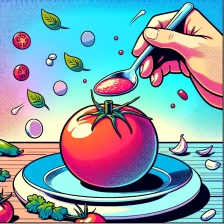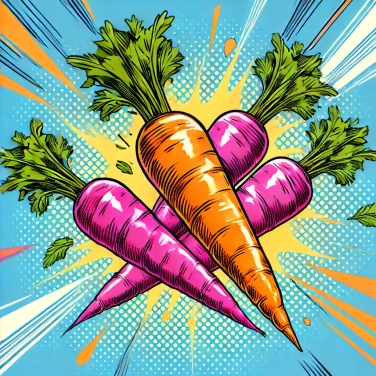In detail, for those interested!
Pigments in carrots
Carrots contain several types of pigments responsible for their characteristic color. The main pigment present in carrots is carotene. There are two main forms of carotene present in carrots: beta-carotene and alpha-carotene. These pigments belong to the carotenoid family, which are organic compounds with red, yellow, or orange coloring widely present in the plant kingdom.
Beta-carotene is the pigment responsible for the orange color of carrots. It is also a precursor to vitamin A, essential for vision, the immune system, and skin health. In addition to beta-carotene, carrots contain other carotenoids such as lycopene (red pigment) and lutein (yellow pigment).
These pigments play a crucial role in plant photosynthesis, absorbing sunlight to produce energy. They act as antioxidants, protecting cells from damage caused by free radicals. In addition to their biological role, the carotenoids present in carrots also offer health benefits to humans as antioxidants and precursors to vitamin A.
Story of the orange carrot
The carrot as we know it today comes from Asia Minor and the Middle East. Originally cultivated for its leaves and seeds, the wild carrot was purple, white, yellow, or violet, but never orange. It was only later, in 17th century Netherlands, that carrot growers developed the orange variety we have today, in honor of the House of Orange-Nassau. This orange carrot was sweeter and more tender than earlier varieties, quickly becoming popular in Europe and beyond.
Influence of the environment on the color of carrots
Carrots come in a variety of colors, ranging from purple to white to yellow. The most common and recognizable color of carrots is orange, but this is not just a coincidence. In fact, the orange color of carrots is the result of the presence of specific pigments called carotenoids.
Carotenoids are natural organic compounds that offer a wide range of colors from pale yellow to bright red. One of the most common carotenoids in carrots is beta-carotene, which is a fat-soluble pigment responsible for the characteristic orange hue of these vegetables.
The environment in which carrots grow can impact their color. Studies have shown that light intensity, temperature, and soil composition can influence the concentration of carotenoids in carrots. For example, carrots grown in potassium-rich soils tend to have higher levels of beta-carotene, which enhances their orange color.
Additionally, exposure to ultraviolet light can increase the production of carotenoids in carrots, intensifying their color. On the other hand, prolonged exposure to high temperatures can alter the composition of carotenoids and result in a change in the color of carrots.
In summary, the orange color of carrots is the result of the presence of carotenoids, but environmental factors such as light, temperature, and soil can influence the concentration of these pigments and therefore the final hue of the carrots we see on our plates.
![Explain why some countries change time zones?]()
![Explain why chilling the butter before working it into puff pastry dough ensures a better texture.]()
![Explain why Alexander the Great refused to wear shoes.]()
![Explain why Alexander the Great always wore an impressive helmet.]()




















